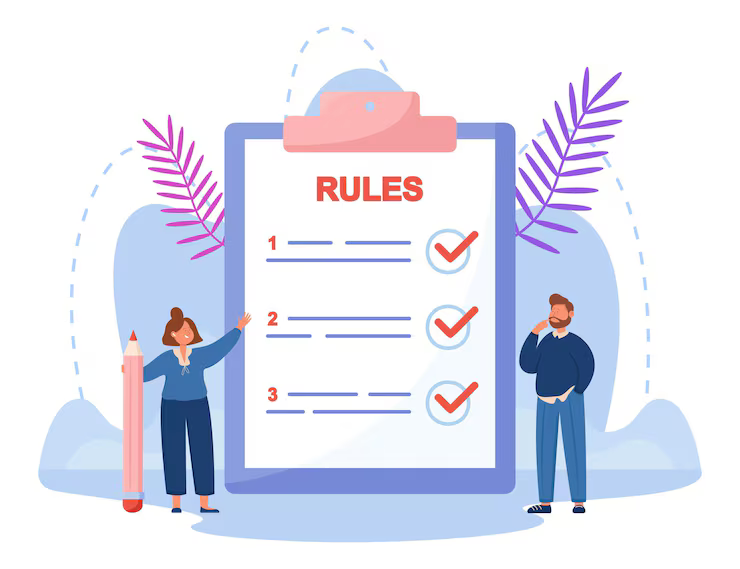Funding challenges from prop firms offer talented traders a golden opportunity to manage large capital without risking their own money. However, this journey is fraught with obstacles and many traders fail even during the challenge phase. In this post, ReviewPropfirm will look at the 5 most common prop firm challenge mistakes and give suggestions on how avoid them.
Mistake #1: Ignoring The Rules and Risk Limits
One of the first and most harmful prop firm challenge mistakes is not following the rules and risk limitations. These regulations aren’t just “frameworks” that the prop firm sets up; they’re important rules that keep both the prop firm and the trader safe from unnecessary risks.
Many impatient traders who want to quickly achieve their profit targets often ignore daily drawdown limits, maximum drawdown limits or trading time rules. This not only leads to automatic disqualification from the challenge but also forms undisciplined trading habits, which are extremely dangerous in the long run.
How to Avoid This Mistake
To avoid falling into prop firm challenge mistakes due to risk rule violations, you should take the following steps:
- Master the prop firm’s rules before starting the challenge: Before you start any challenge, be sure to read each term from the prop firm thoroughly. These include daily drawdown, maximum drawdown, minimum trading days and order volume rules. These are important parameters that help you clearly define the safe zone for trading and avoid being eliminated due to a technical error.
- Develop a clear plan for trading and manage risk in the right way: The trading plan should have realistic profit goals, maximum daily loss levels, the right risk ratio for each order and a stop-trading point when a threshold is reached. Don’t trade emotionally or chase the market; this can easily cause you to break the rules provided by the prop firm.
- Set a stop-loss every time: One of the most common mistakes is not being disciplined about setting stop-losses. There should be a defined stop-loss point for every trade to protect the account, especially when the market is unstable.
- Keep an eye on performance and change your plan when necessary: You can keep track of how you’re doing in the challenge by using a trade journal or a performance management tool. This not only helps you find mistakes in your trading technique, but it also lets you change your strategy to fit the strict rules of prop firms.

Mistake #2: Overtrading and Revenge Trading
“Overtrading” and “revenge trading” are among the most frequent prop firm challenge mistakes and they can be especially harmful in the demanding environment of proprietary trading.
When a trader makes too many trades in a short amount of time without enough market rationale, this is called overtrading. It is frequently the result of impatience, a desire to achieve target profits rapidly, or simply bored when the market lacks clear signals.
On the other hand, revenge trading is an emotional reaction to losing a trade. Traders don’t accept their losses and stick to the strategy; instead, they try to “make up” for them right away by placing more orders without doing enough research and while their minds are not stable.
Both habits increase risk, transaction costs and most crucially, diminish discipline, which is essential for conquering problems.
How to Avoid This Mistake
To avoid falling into prop firm challenge mistakes like overtrading or revenge trading, the following steps must be acknowledged:
- Limiting the number of trades in a day: When traders watch the market change, they often get a “itchy trigger finger,” which makes them keep entering trades even when the indications aren’t obvious. This makes it easy to break the prop firm’s rules and makes risk build up quickly.
- Avoid trading after a loss: Losing trades can cause anger and regret, causing traders to “make up” by starting the next trade. This is an absurd move that often leads to bigger losses.
- Re-evaluate your psychology and strategy after each trade: Continuously trading without stopping to review results, emotions and plan adherence can easily lead you down a path of mistakes without you realizing it.

Mistake #3 – Using Unrealistic Trading Volumes or Leverage
This is one of the common prop firm challenge mistakes, especially rookie traders or traders who have been around for a while and want to attain their profit target as rapidly as possible.
A lot of traders try to “skip steps” by using trading volumes that are too high for their capital or by using leverage at the fund’s maximum level.Although this can be highly profitable if the market moves in the right direction, it also means that the risk of loss is multiplied many times over.
An unexpected small fluctuation can easily push you to your daily drawdown limit or maximum drawdown, leading to immediate failure. Prop firms design challenges not only to find profitable traders but also those who can manage risk cautiously and sustainably. Using too much volume and leverage shows that you don’t know how to manage risk and aren’t disciplined, which is not something any funding fund would want in a professional trader.
This is one of the most underestimated prop firm challenge mistakes, yet it leads to immediate disqualification for many traders.
How to Avoid This Mistake
This is one of the most common prop firm challenge mistakes, where traders take unrealistic risks. To avoid falling into this mistake, you should take the following steps:
- Trade with the right amount of volume for the challenge account: Always base trade volume on the challenge’s authorized risk level. Even if you are absolutely sure about the signal, you should not risk more than 1-2% of your account on every trade.
- Understand the impact of leverage and control it reasonably: High leverage can be appealing, but it can also quickly lead to you blowing your account. Leverage should only be used as a flexible support tool, not to double profits in the short term.
- Maintain consistency in capital management: Erratic, emotional changes in volume are a very common mistake that challenges prop firms. Develop a clear and consistent capital management strategy and stick to it regardless of the outcome of your most recent trades, whether they are wins or losses.
- Set realistic goals and persevere: Don’t stress out too much over reaching your goal in the first few days. The most important things that will help you get through tough times are stable, safe and disciplined trading.
Mistake #4 – Lack of a Good Trading Plan
A lot of traders have problems with a “try your luck” attitude or just a few technical indicators that aren’t part of a clear plan. Not having a good trading plan is one of the most basic yet serious mistakes.
A trading strategy is more than simply a spot to write down your entry and exit signals. It is a full record that tells you how you will deal with the market in any situation, including how to handle risk, manage your money and deal with emotional factors.
Without a plan, traders easily go off track, acting on impulse or temporary news, leading to impulsive decisions and inconsistent results. Especially in a challenging environment where every mistake can lead to elimination, lacking a detailed trading “map” is a surefire path to failure.
How to Avoid This Mistake
Not having a plan is a classic example of prop firm challenge mistakes that prevent consistent success. To avoid this mistake, the following things must be acknowledged:
- Clearly define your trading goals and style from the outset: You need to know whether you are trading with or against the trend, using technical or fundamental analysis, which timeframes are suitable and what your desired Risk:Reward ratio is.
- Develop specific trading rules: Clearly define entry criteria, exit conditions, how to identify support and resistance zones, when not to trade and how to handle strong market fluctuations.
- Maintain consistency and periodically evaluate effectiveness: One of the mistakes that challenge prop firms is changing strategies after just a few losing trades. You need to be consistent with the system you’ve built, while also evaluating performance weekly or monthly for reasonable adjustments, without reacting on a whim.
- Record and reflect on each trade: Recording executed orders along with the reasons for entering the trade, the results and your emotions helps you identify weaknesses in your system or psychology, allowing you to improve your trading plan and make it increasingly perfect.
Building and adhering to a solid trading plan is a guiding principle for consistency and discipline, especially in the high-pressure environment of prop firm challenges.

Mistake #5 – Trading with Emotions
In trading, emotions are a factor that can cause us to lose control and make unwise decisions. Under the pressure of time, strict risk limits and the expectation of achieving profit targets in a short period, many people are easily drawn into a state of mental instability.
Among the most common prop firm challenge mistakes is allowing emotions like anxiety when losing, euphoria after a big win, regret for missing an opportunity, or fear when the market reverses to take over. These feelings can make you stray from your planned course of action. If your mental state is unpredictable, every trade you make could be a dangerous bet that costs you money.
How to Avoid This Mistake
Emotional decisions often lead to prop firm challenge mistakes that wipe out otherwise profitable accounts. To avoid falling into this mistake, you should take the following steps:
- Learn how to spot emotions in trading: Being able to see and accept your own feelings can help you avoid reacting without thinking. When you realize you’re trading out of anger, fear, or overconfidence, take a break.
- Always stick to your trading plan: A trading plan is a roadmap that helps you maintain consistency. When emotions arise, returning to your plan will help you adjust your behavior back on track.
- Set daily trading stop-loss rules: If you reach your profit or loss target, stop trading immediately even if there are still opportunities in the market. This helps limit continued trading when emotions are no longer stable.
- Take regular breaks and maintain a balanced mindset: Mental stability doesn’t come from the market, it comes from within you. Getting enough sleep, eating properly and avoiding trading when stressed or unfocused are important ways to avoid making prop firm challenge mistakes driven by emotions.
Participating in prop firm challenges is a great opportunity for traders to demonstrate their abilities and gain access to professional trading capital. However, this is not just a game of numbers and charts, but also a battle between reason and emotion. The prop firm challenge mistakes ReviewPropfirm list in this article are the leading causes of failure for many capable traders, but by recognizing and avoiding them, you can greatly improve your chances of passing and securing funding. Identifying and avoiding these prop firm challenge mistakes from the outset will help you build a solid trading mindset, laying the foundation for stability and sustainability throughout your trial period and future trading career.
